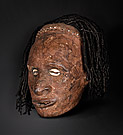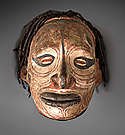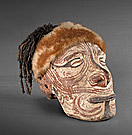Exhibition themes Middle Sepik
The well-known Iatmul people are a large community with many of their villages situated on the banks of the Sepik. Each village has one or more of the impressive ngeko ceremonial houses, the keeping place for ritual objects essential to the wellbeing of the community. The ceremonial house is central to political, social and ritual life for Iatmul men, who spend their spare time relaxing on raised platforms under the shade of the ground floor of the ngeko. Each ceremonial house has large spectacularly carved support posts decorated with clan-associated images.
Iatmul art is typically elaborately carved sculpture and painting that excels in flowing curvilinear designs, and is perhaps the most recognisable of all the arts of the Sepik. Traditionally, the Iatmul were the dominant culture of the Sepik River and are acknowledged for their reputation as headhunting raiders. They controlled a major part of the Sepik and developed trade partnerships with their northern and southern neighbours.
To the north of the Iatmul are the Sawos people who live in grasslands away from the Sepik’s floodplain. The Sawos have a close relationship with the Iatmul and share many cultural aspects.





![| Samban [suspension hook] | Early to mid 20th Century prior to 1963](images/sml/159691.jpg)
![| Samban [female figure from a suspension hook] | 19th to early 20th Century](images/sml/176442.jpg)






